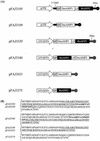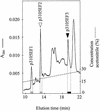Transgenic expression in Arabidopsis of a polyprotein construct leading to production of two different antimicrobial proteins
- PMID: 11950983
- PMCID: PMC154262
- DOI: 10.1104/pp.010794
Transgenic expression in Arabidopsis of a polyprotein construct leading to production of two different antimicrobial proteins
Abstract
We developed a method for expression in Arabidopsis of a transgene encoding a cleavable chimeric polyprotein. The polyprotein precursor consists of a leader peptide and two different antimicrobial proteins (AMPs), DmAMP1 originating from Dahlia merckii seeds and RsAFP2 originating from Raphanus sativus seeds, which are linked by an intervening sequence ("linker peptide") originating from a natural polyprotein occurring in seed of Impatiens balsamina. The chimeric polyprotein was found to be cleaved in transgenic Arabidopsis plants and the individual AMPs were secreted into the extracellular space. Both AMPs were found to exert antifungal activity in vitro. It is surprising that the amount of AMPs produced in plants transformed with some of the polyprotein transgene constructs was significantly higher compared with the amount in plants transformed with a transgene encoding a single AMP, indicating that the polyprotein expression strategy may be a way to boost expression levels of small proteins.
Figures






References
-
- Barker RF, Idler KB, Thompson DV, Kemp JD. Nucleotide sequence of the T-DNA region from Agrobacterium tumefaciens octopine Ti plasmid pTi15955. Plant Mol Biol. 1983;2:335–350. - PubMed
-
- Bechthold N, Ellis J, Pelletier G. In planta Agrobacterium mediated gene transfer by infiltration of adult Arabidopsis thaliana plants. C R Acad Sci Paris. 1993;316:1194–1199.
-
- Becker D, Kemper E, Schell J, Masterson RAD. New plant binary vectors with selectable markers located proximal to the left T-DNA border. Plant Mol Biol. 1992;20:1195–1197. - PubMed
-
- Beck von Bodman S, Domier LL, Farrand SK. Expression of multiple eukaryotic genes from a single promoter in Nicotiana. Bio/Technology. 1995;13:587–591. - PubMed
Publication types
MeSH terms
Substances
LinkOut - more resources
Full Text Sources
Other Literature Sources

